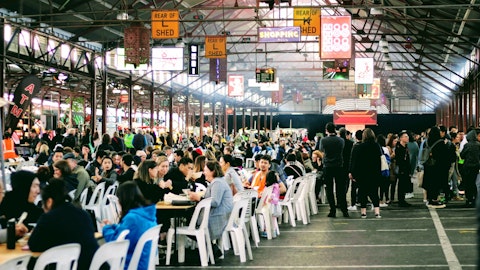Jon Tower: Great. Thanks for taking the question. Curious, Brian, you mentioned earlier in the call that your smaller market stores are coming in strong, perhaps even better than you had anticipated. So I’m curious, I know you’ve recently offered the 7,000-store TAM for North America. But given the success you’re seeing as well as some of the new technology like the clamshell grills that you’re still testing or you can heighten on the horizon, does that maybe alter that opportunity for new stores over time?
Brian Niccol: I mean, look, obviously, as we get closer to that 7,000 number. We’ll have a much better idea of whether or not we can grow beyond the 7,000. The good news is we’ve not seen any slowdown in our performance. So all the restaurants we’re opening. They’re opening with strength. And obviously, we look at this every year as we kind of take another look at our market planning. And the good news is we’re opening restaurants in — for Chipotle, I would say, somewhat penetrated markets, and they continue to perform really well. And that gives us confidence because then we can kind of start thinking through like, well, you start extrapolating that across the country, you could see how you could get beyond 7,000. But not ready to take the number up just yet.
I love seeing great performance. It’s great to see the small towns do really well. And it’s great to see, frankly, the restaurants do really well in urban and are more penetrated markets. So lots of opportunity in front of us on new restaurant opening frontier.
Jon Tower: Great. And just one more follow-up. Do you have any more planned LTOs for 2023?
Brian Niccol: We always think through kind of something in the front half and something in the back half. We haven’t definitively made a decision on what we’re going to do in the back half yet. The good news is our pipeline is really strong, and we’ve got some flexibility. But we want to see where the consumer is, the strength of Project Square One and that will inform what we choose to do in the back half of the year.
Jon Tower: Got it. Thank you.
Operator: The next question comes from Peter Saleh with BTIG. Please go ahead.
Peter Saleh: Great. Thanks for taking the question. Brian, I want to ask about the hyphen automation. I think you mentioned that’s for the digital make line. When you’re thinking about this, and I know it’s still early, is this more for new restaurants? Or can you fit this into your existing footprint in some of your existing locations?
Brian Niccol: Yes. No, one of the things that’s great about this is it would fit in our existing locations. It’s almost pull off the current line, put in the new line kind of idea, which is really exciting. Probably the first place you’d see us do it. It will be with new units just because it’s easier to implement. But the good news is Kurt and the team are designing this so that it will work with our existing restaurants.
Peter Saleh: Great. And then just one question on the Chicken Al Pastore LTO. It sounds like it’s performed exceptionally well. Is it bringing in new guests to the brand previously haven’t come to Chipotle? And is there a level at which an LTO has so much success that it becomes a permanent item? Or do you always consider it as an LTO?
Brian Niccol: Yes. Well, the good news is Chicken Al Pastore has been broadly appealing. So both to new users and existing customers. The decision to make it permanent would be something we would do after we finish this LTO 1. So we haven’t come to the conclusion that we would make this permanent, but your statement is correct, it’s definitely performing really well. And crew member feedback is this is an easy one for them to make, and customer feedback has been really positive as well. So we did decide to make the Fajita Quesadilla permanent in our digital platform, but that’s a little different than making Chicken Al Pastore permanent. So for this one, it’s definitely planned to be an LTO, we’ll execute it as an LTO, and then we can always revisit whether we make a permanent menu item down the road.
Peter Saleh: Thank you.
Operator: The next question comes from Jeffrey Bernstein with Barclays. Please go ahead.
Jeffrey Bernstein: Great. Thank you very much. Two questions. The first one is on the comp guidance. The fact that you’re resuming guidance for full-year. I assume that’s an indication of stabilization that you’re seeing maybe more week-to-week or month-to-month or your visibility — just wondering if you can share why that has returned. And maybe what are the components you’re assuming in that mid to high-single-digit in the 2Q and full-year? Just trying to gauge what the pricing would be if you took no further and what the traffic assumption is? And then I just had one follow-up.
John Hartung: Yes. On the guidance, it assumes we don’t take any additional pricing similar to the comment that Brian made before. Right now, we’re staying the course. So what it assumes is we continue the same transaction trends that we’ve seen in the first quarter continue into second quarter. It recognizes that we took some menu price action last year, and those will roll off. And so that’s, in essence, what we put together for the full-year guidance. And the idea here, Jeff, is that we don’t know if we’re going to continue like beyond the next few quarters and give quarterly guidance all the time. You might remember a few years ago, we used to give just the annual and then not talked about what the quarterly guidance is.
And so what we’re doing right now is we’re kind of doing both for a while, and then we’ll see how the trends unfold. We’ll see what happens to the macro. And we’ll make a decision in terms of what our guidance is going to be. But we actually think about our business in terms of a longer-term approach than quarter-to-quarter. And so we think the guidance ought to match that as well. So that’s the reason for the change.
Jeffrey Bernstein: Understood. And then just on the marketing front, I think you said the mid-2% range for the second quarter. I know it was in the 3s in the first quarter. I’m just wondering, just talk about the thought process around marketing, whether this is a conscious pullback for any particular reason or how you measure the returns kind of your how happy have you been with the marketing you’ve had thus far and the outlook going forward? Thank you.
Brian Niccol: Well, we’ve been really happy with how the brand has shown up and the initiatives that we’ve rolled out on the percentages, I think that has more to do with timing than anything else.
John Hartung: It’s timing. It’s been planned, and we tend to spend more in the first quarter first part of the year and in the back half of the year and typically to support these LTOs.
Brian Niccol: Well, I think Chris here, you’d also say too, like the summer months aren’t the best time for broad-based media, right? So I think that’s part of the timing.
Peter Saleh: Thank you.
Operator: Today’s last question comes from Jake Bartlett with Truist Securities. Please go ahead.





